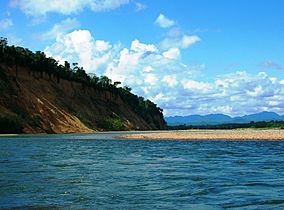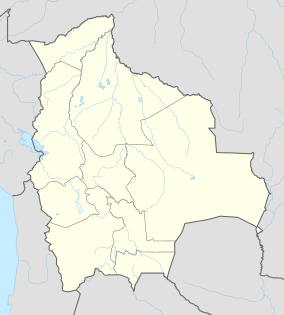Madidi National Park facts for kids
Quick facts for kids Madidi National Park |
|
|---|---|
|
IUCN Category II (National Park)
|
|

Madidi National Park, Bolivia
|
|
| Location | La Paz, Bolivia |
| Nearest city | Rurrenabaque, Beni |
| Area | 18,957.5 km² |
| Established | September 21, 1995 |
| Governing body | SERNAP Servicio Nacional de Áreas Protegidas |
Madidi is a huge national park in Bolivia, a country in South America. It's located in the upper part of the Amazon river basin. Madidi was created in 1995 and covers a massive area of about 18,958 square kilometers. That's bigger than many countries!
Madidi is part of one of the largest protected areas in the world. It connects with other special places like Manuripi-Heath, Apolobamba, and the Manu Biosphere Reserve in Peru.
This amazing park stretches from the high Andes Mountains down to the warm rainforests of the Tuichi River. Because of this, Madidi is known as one of the most biodiverse places on Earth. This means it has a huge variety of plants and animals. It protects parts of the Bolivian Yungas and Bolivian montane dry forests ecoregions.
You can visit Madidi National Park from a town called San Buenaventura. To get there, you cross the Beni River by ferry from Rurrenabaque.
Many different groups of people live in and around the park. Some have moved from the high Andes and speak the Quechua language. Other groups, like the Tacana, Ese Ejja, Tsimané, and Mosetén, have lived there for a very long time. There are even some isolated groups like the Toromona who choose to live without contact with the outside world.
There are also special places called ecolodges in Madidi. These lodges help visitors explore the park while also supporting the local communities. The oldest and most famous is Chalalan Ecolodge, which is run by local indigenous people.
Contents
Where is Madidi National Park?
Madidi National Park and Integrated Management Natural Area is located in the northwest of the La Paz Department in Bolivia. It spans across several provinces and municipalities.
The park shares its borders with other important protected areas. To the west, it connects with the Tambopata-Candamo Reserve and Bahuaja-Sonene National Park in Peru. To the east and north, it borders indigenous community lands. To the south, it's next to the Apolobamba Integrated Management Natural Area and the Pilón Lajas Biosphere Reserve and Communal Lands.
Madidi is one of Bolivia's largest protected areas. It covers about 18,957.5 square kilometers. A big part of this is a National Park, and another part is an Integrated Management Natural Area. This means some areas are strictly protected, while others allow for sustainable use by local communities.
The park's elevation changes a lot, from 180 meters (about 590 feet) above sea level up to 5,760 meters (about 18,898 feet). This huge range in altitude creates many different types of environments.
What's the Weather Like in Madidi?
The weather in Madidi changes a lot depending on how high up you are. In the highest parts, it's cold, like an alpine region. In the middle elevations, the weather is mild. Down in the northern lowlands, it's hot and tropical.
Winds mostly come from the north. Cold fronts from the south don't usually make the Madidi region much colder. The dry season happens during the southern winter, from May to September. The average temperature for the whole year is about 26 °C (79 °F), but this can be very different depending on the altitude.
In the Apolo region, the park gets about 716 mm (28 inches) of rain each year. The rainy season is from October to March, and the dry season is from May to September.
Amazing Plants of Madidi
Madidi National Park is a plant paradise! Scientists have found more than 8,000 different kinds of vascular plants here. And they believe there are many more waiting to be discovered.
The Madidi Project, a group of plant experts, had already found at least 132 new plant species in Madidi by 2010. This shows how incredibly rich in plant life the park is.
Incredible Animals of Madidi
Madidi is home to an amazing variety of animals. A wildlife biologist named Dr. Robert Wallace even discovered a brand new species of titi monkey here! This monkey lives only in Madidi.
To help protect the park, the right to name this new monkey was auctioned off. An online casino won the auction and paid US$650,000. This money created a special fund that now pays for fourteen park rangers every year. The monkey was named Plecturocebus aureipalatii, which means "of the Golden Palace" (after the casino).
The park is also famous for its birds. It has over 1,254 different bird species! That's about 14% of all the bird species in the entire world.
Besides the animals on land, Madidi's waters are full of life too. There are many different kinds of fish species living in its rivers and streams.
Here's a quick look at some of the animal groups found in Madidi (not including species that haven't been officially described yet):
- Mammals: 272 species
- Birds: 1,254 species
- Fish: 496 species
- Amphibians: 213 species
- Reptiles: 204 species
- Insects: Madidi has more than 120,000 different species of insects!
Visiting Madidi: Fun and Eco-Friendly!
Madidi National Park is a great place for responsible tourism and community ecotourism. This means that when you visit, you help protect the environment and support the local people.
One of the most well-known places to stay is Chalalan Ecolodge. It's owned by the indigenous people of San José de Uchupiamonas. The money earned from the lodge helps their community with things like health and education. Chalalan has been open since 1999.
When you visit Chalalan, you travel from Rurrenabaque to the lodge by boat, cruising along the Beni and Tuichi rivers. You stay in comfortable cabins built in the traditional Tacana style. The food is a mix of international and Amazonian dishes. Local indigenous guides, who speak Quechua and Spanish, lead tours. They are trained and certified to show you around the park.
Chalalan uses solar panels for clean energy and has systems to manage waste and treat wastewater. This helps reduce its impact on the environment. The lodge has 9 cabins near Lake Chalalan. It also has 30 km (18 miles) of trails for exploring, canoes for paddling on the lagoon, and a big dining area. Most visitors stay for 4 days and 3 nights.
Other local ecotourism places in Madidi include San Miguel del Bala Ecolodge, Berraco del Madidi Amazon adventure tour, Madidi Jungle Ecolodge, and Sadiri Ecolodge.
Sadiri Lodge: Protecting the Forest
Sadiri Lodge was created to help protect Madidi's amazing forest from activities like logging and deforestation. It's a non-profit community tourism project that also helps local communities develop. Sadiri Lodge is managed by members of the San José De Uchupiamonas Indigenous People. Their main goal is to protect 34,000 hectares (about 84,000 acres) of untouched forest, water sources, and all the creatures that live there.
The forest around Sadiri Lodge is a refuge for many species. It has over 430 species of birds, which shows how important the area is for nature. You can also find many reptiles, insects, amphibians, and beautiful plants like bromeliads and orchids. Because it's at 900 meters (about 2,950 feet) above sea level, the climate is pleasant. You might hear different kinds of monkeys singing in the morning or see them jumping through the trees. Birds create a natural symphony. Hummingbirds flutter around, and colorful insects and butterflies add to the beauty. Expert local guides from Uchupiamonas share their knowledge of the forest and their culture, making visits unforgettable.
Berraco Madidi Amazon Adventure Tour
Berraco Madidi Amazon adventure tour is another local initiative. It was started by a member of the Quechua-Tacana indigenous community of José de Uchupiamonas. It began in 2010 and is run entirely by people from the community. This helps create jobs and benefits for them. The camps, called Ecocamps, are deep inside Madidi National Park. They are about 6 hours away by boat and have cabins built in the traditional Quechua-Takana style using natural materials.
Madidi Jungle Ecolodge
Madidi Jungle Ecolodge opened in mid-2011. It's also a local project run by indigenous families from the TCO San José de Uchupiamonas. This lodge is about 3.5 hours by motorboat from Rurrenabaque, traveling upstream on the Beni and Tuichi rivers. It can host 14 visitors in traditional Amazonian-style cabins.
All these ecotourism businesses in Madidi National Park offer comfortable boat transportation, unique places to stay, excellent local guides, and delicious homemade food made from local products. Visiting the Bolivian Amazon from Rurrenabaque is an unforgettable adventure!
Protecting Madidi: What Are the Challenges?
Madidi National Park faces some challenges that could harm its amazing nature and wildlife.
The Bala Dam Project
One big threat has been the idea of building a large hydroelectric dam project at the Beni River in the Bala Gorge. This project has been discussed for a long time. If built, the dam would cause a huge area, about 2,000 square kilometers (770 square miles), to be flooded. This would include a large part of Madidi National Park, which would be very bad for the environment and the animals living there.
Also, if the dam were to break, it could cause a disaster. Studies suggest that the entire area could be flooded for several days.
The Apolo-Ixiamas Road Project
Another major threat to Madidi is the proposed construction of a road between Apolo and Ixiamas. Some local politicians and communities want this road to make it easier to cut down trees and use the land for farming inside the park.
However, independent studies have shown that this road project is not a good idea for the region. It would be very expensive and would cause a lot of deforestation (cutting down trees) within the protected area.
The environmental damage from the road could harm the park's conservation efforts and tourism activities. These activities actually bring important economic benefits to the region. Instead of building the road, other ideas like improving the existing road to La Paz or investing in health and education could better improve the quality of life for local people, while also protecting Madidi's important natural services.
See also
 In Spanish: Parque nacional Madidi para niños
In Spanish: Parque nacional Madidi para niños



